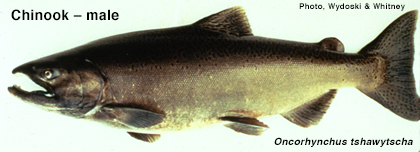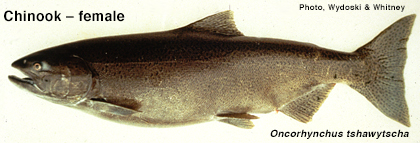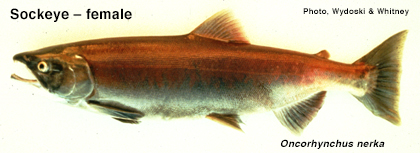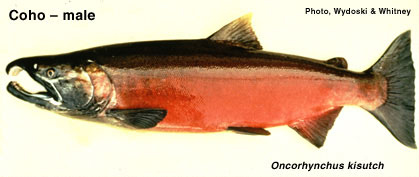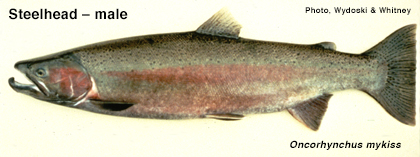Without human beings, salmon have no names, but because we are able to distinguish one from another, their differences have become words and, to some of us, a litany.”[1]Tom Jay and Brad Matsen, Reaching Home: Pacific Salmon, Pacific People (Anchorage: Alaska Northwest Books, 1994), p. 47. They’re American words, Indian words transformed by folk etymologies, Greek words, Russian words.
Meriwether Lewis and William Clark observed and described four fish belonging to the Salmonid family that were previously unknown to scientists, and that were basic foods for thousands upon thousands of Indians west of the Rockies, but also for grizzly bears on the west slope of the Bitterroot Mountains. The explorers’ perceptions were necessarily incomplete, since they saw these fish for brief periods and only at certain times of the year, yet they were generally accurate as far as they went.
These four fish are anadromous (from the Greek for “running up”) spending their adult lives in the Pacific Ocean, then literally sniffing their way up coastal rivers, fighting rapids and leaping falls as much as fifteen feet high, until they reach their natal nesting places. There the females dig pits in gravely places, the males fertilize the eggs with their milt, and the females cover the eggs with gravel. The new salmon, called fry, hatch in from 60 to 200 days, depending on the temperature of the water. After eating the yoke of the egg sac in which they were born, the fry wriggle out of their gravel nests to find more food, and their own great, mysterious, miraculous journey begins.
As they work their way upriver, the silvery Pacific salmon change color, and the males gradually develop hooked noses (oncorhynchus is a Greek word meaning “hooked [onkos] nose [rhynchos]“), then both parents die. Steelhead trout (Oncorhynchus mykiss), and Atlantic salmon (of the genus Salmo), however, may spawn several times before their demise.
First Encounters
On 13 August 1805, at the Shoshone camp on the Lemhi River in Idaho, an Indian . . . himself extremely short on rations . . . hospitably gave Lewis “a small morsel of the flesh of an antelope boiled, and a piece of a fresh salmon roasted, both which I eat with a very good relish. This was the first salmon I had seen and perfectly convinced me that we were on the waters of the Pacific Ocean.” The Captains immediately made important contributions to the forthcoming science of ethnobiology with their detailed descriptions and drawings of the Indians’ fish traps (weirs) and spearing (gigging) techniques.
After their tortuous, hungry crossing of the Bitterroot Mountains they arrived at the forks of the Clearwater River in late September, evidently at the end of the fall salmon run. “one of the young men took his gig and killed 6 fine Salmon. Two of them were roasted and we eate.” By the first day of October they, as well as their Nez Perce Indian hosts, were reduced to eating dried salmon, “which the men [of the Corps] complain of as working on them as much as a dose of Salts.” Tainted with bacteria to which the men’s stomachs were unaccustomed, it produced the same effect as glauber salts, a common emetic.[2]Patrick Gass, on the other hand, offered a different explanation for their gastrointestinal distress: “The water also is soft and warm, and perhaps causes our indisposition more than any thing … Continue reading
They were astonished at the numbers of salmon they saw upon their arrival at the Columbia River on 18 October 1805. “We Saw a great many dead Sammon floating in the River,” wrote Sergeant John Ordway, “and Saw the living jumping verry thick.” Clark added that “the number of dead Salmon on the Shores & floating in the river is incrediable to say.” Ignorant of the species’ life cycle, none of the journalists ventured any theories about what they saw, and evidently heard no explanations from the Indians.
Spring Encounters
Homeward bound on 17 April 1806, the passed through the vicinity of The Dalles, Oregon, and Celilo Falls. The Expedition members—not to mention the local Indians—were anxious: “the salmon not having made their appearance proves a serious inconvenience to us.”
While camped near the Nez Perce village while waiting for the snow-choked Bitterroot mountains to thaw a little, both the Corps and the Indians eagerly looked forward to the arrival of the spring salmon run. On 18 May 1806, Lewis wrote:
Early this morning the natives erected a lodge on the opposite side of the river near a fishing stand a little above us, no doubt to be in readiness for the salmon, the arrival of which they are so ardently wishing as well as ourselves.
Lewis assumed the salmon run was related to the stage of spring runoff. At Camp Chopunnish on 2 June 1806, he wrote:
I begin to lose all hope of any dependence on the Salmon as this river will not fall sufficiently to take them before we shall leave it, and as yet I see no appearance of their runing near the shores as the indians informed us they would in the course of a few days.
He was in a tight spot:
I find that all the salmon which they procure themselves they obtain on Lewis’s river, and the distance thither is too geat for us to think of sending after them even had we merchandize with which to purchase.
In desperation, following the advice of the Indians, he sent Sergeant Ordway and Privates Robert Frazer and Weiser on a long trek over to “Lewis’s River” (today’s Snake River) to get salmon (see Ordway’s Salmon Fishing Trip). Setting out on 27 May 1806, they understood from their Indian informants that the Snake was only a half day’s ride to the south, but it proved to take three days, and they didn’t get back to “Camp Chopunnish” until noon on 2 June. Most of the 17 salmon they brought were nearly spoiled, but the rest were edible. “Those which were sound,” wrote Lewis, “were extreemly delicious. Their flesh is of a fine rose color with a small admixture of yellow.”
Chinook, “Common Salmon”
Kshawytscha is the Russian name for this species around Kamchatka, USSR. The word chinook, probably from the Indians of the same name who lived at the mouth of the Columbia River, entered the English language around the middle of the 19th century.
The largest of the family Salmonidae, chinook can grow to nearly five feet in length, and more than 100 pounds in weight, though most mature specimens are under 50 pounds. Chinook can therefore cope with faster currents, and will spawn during spring runoff, as well as in the summer and fall. It was the mainstay of Indian economy throughout the coastal river systems, and is still the most important salmon in the sport and commercial arena.
Lewis described the chinook, or king, salmon on 13 March 1806, while at Fort Clatsop:
The common Salmon and red Charr [sockeye salmon] are the inhabitants of both the sea and rivers. The former is usually largest and weighs from 5 to 15 lbs. It is this species that extends itself into all the rivers and little creeks on this side of the Continent, and to which the natives are so much indebted for their subsistence.
The body of this fish is from 2-1/2 to 3 feet long and proportionably broad. It is covered with imbricated [overlapping] scales of a moderate size and is variegated with irregular black spots on its sides and gills. The eye is large, and the iris of a silvery colour, the pupil black.
The rostrum or nose extends beyond the under jaw, and both the upper and lower jaws are armed with a single series of long teeth which are subulate [tapering to a point] and inflected [bent inwards] near the extremities of the jaws where they are also more closely arranged. They have some sharp teeth of smaller size and same shape placed on the tongue, which is thick and fleshy.
The fins of the back are two. The first is placed nearer the head than the ventral fins, and has [blank] rays; the second is placed far back near the tail, is small, and has no rays.
The flesh of this fish is, when in order [mature and healthy, before the end of the spawning run], of a deep flesh coloured red and every shade from that to an orange yellow, and when very meager [old and thin] almost white.
The roes [eggs] of this fish are much esteemed by the natives, who dry them in the sun and preserve them for a great length of time. They are about the size of a small pea, nearly transparent, and of a reddish yellow colour. They resemble very much at a little distance the common currants of our gardens but are more yellow.
This fish is sometimes red along the sides and belly near the gills, particularly the male.
Sockeye, “Red Charr”
Sockeye live in freshwater lakes for their first two to three years, then spend their adult lives in the Pacific Ocean from the Bering Sea to Southern California to Northern Japan. Their sensitivity to habitat deterioration had threatened their survival, and they were the first anadromous species to be listed under the Endangered Species Act. They are still on the verge of extinction.
Mature sockeye weigh in at an average of only about six and one-half pounds. Yet they can migrate more than a thousand miles to reach preferred spawning beds.
A subspecies, called kokanee (O. n. kennerlyi) is a smaller, landlocked relative.
Captain Lewis identified the fish now called sockeye as the “red Charr,” but the char belongs to the genus Salvelinus . . . the old European term for char. These fish, he wrote on 13 March 1806:
are reather broader in proportion to their length than the common salmon [chinook; Oncorhynchus tshawytscha]. The scales are also imbricated [overlapping] but reather large. The nostrum [nose] exceeds the lower jaw more, and the teeth are neither as large nor so numerous as those of the salmon.
Some of them are almost entirely red on the belly and sides; others are much more white than the salmon [chinook] and none of them are variegated with the dark spots which make the body of the other.
Their flesh, roes, and every other particular with respect to their form is that of the Salmon.
This fish we did not see until we descended below the great falls of the Columbia [Celilo Falls], but whether they are exclusively confined to this portion of the river or not at all seasons, I am unable to determine.
Coho, “White Salmon Trout”
Kisutch is the Russian name for this fish around Kamchatka, USSR. The coho salmon, identifiable by the small spots on the back and upper tail-fin lobe, stays in fresh water for its first year, then swims down river to the Pacific Ocean, where it matures in about three years. Average adults weigh about ten pounds, though the largest recorded coho, 38.5 inches long, weighed 31 pounds. The common name coho possibly evolved from the word Halkomelem, from a Salishan dialect of southwest British Columbia.
Mature coho salmon have dark blue backs and silver sides, but during the spawning phase they turn bright red on their sides and blue-green on their heads and backs, and develop the hooked nose . . . oncorhynchus . . . as seen in the photo above.
Lewis, calling it the “white salmon trout” described this species on 16 March 1806, at Fort Clatsop:
The white Salmon Trout, which we had previously seen only at the great falls [Celilo Falls] of the Columbia has now made it’s appearance in the creeks near this place . . . . one of them was brought us today by an Indian who had just taken it with his gig.
Drawing a sketch of it, he also painted a beautifully detailed word-picture:
This is a likeness of it; it was 2 feet 8 Inches long, and weighed 10 lbs. …the eye is moderately large, the pupil black and iris of a silvery white with a small admixture of yellow, and is a little turbid near its border with a yellowish brown. …the position of the fins may be seen from the drawing; they are small in proportion to the fish …the fins are bony but not pointed except the tail and back fins, which are a little so, …the prime back fin and ventral ones contain each ten rays; those of the gills thirteen, that of the tail twelve, and the small find placed near the tail above has no bony rays, but is a tough, flexible substance covered with smooth skin. …it is thicker in proportion to its width than the salmon [chinook salmon] …the tongu is thick and firm beset on each border with small subulate teeth in a single series.
Neither this fish nor the salmon are caught with the hook, nor do I know on what they feed.
In general, anadromous fish en route back to their redds do not eat, although they will strike hard at artificial lures.
Steelhead, “Salmon Trout”
In 1992 the steelhead trout, Salmo gairdneri (the species named in memory of Meredith Gairdner, a 19th-century naturalist) was reclassified in the genus Oncorhynchus (“hooked nose”), and mykiss (a Siberian word for the species). There are two races, both native to Western North America. The common name of the freshwater O.m. is rainbow trout, a colorful game fish that has been transplanted worldwide. The sea-run, or anadromous rainbow trout is called steelhead, a word that entered the common nomenclature in the early 1880s.
Unlike salmon, steelhead can spawn several times, although the hydropower dams on the Columbia River system have interfered with that pattern, and the species has been classed as threatened under the Endangered Species Act. On 12 December 2000, biologists for the Yakama Indian Nation released the first of 110 revived and rehabilitated kelts—as between-spawning steelhead are called—into the Yakima and Columbia Rivers. All were wearing identification tags, clipped fins, and inch-long cylindrical radio transmitters in their throats, for tracking, DNA testing, and genetic research.
Record-class steelhead can attain a length of up to 45 inches, and a weight of more than 40 pounds.
Lewis described the “Salmon Trout” on on 13 March 1806, while at Fort Clatsop:
The Salmon Trout are Seldom more than two feet in length. They are narrow in purportion to their length, at least much more So than the Salmon [chinook] & red charr [sockeye]. Their jaws are nearly of the Same length, and are furnished with a Single Series of Subulate [tapered] Straight teeth, not so long or so large as those of the Salmon. The mouth is wide, and the tongue is also furnished with Some teeth. The fins are placed much like those of the Salmon.
At the Great Falls are met with this fish of a Silvery white colour on the belly and Sides, and a bluish light brown on the back and head. In this neighbourhood we have met with another Species which does not differ from the other in any particular except in point of Colour. This last is of a dark colour on the back, and its Sides and belly are yellow with transverse Stripes of dark brown. Sometimes a little red is intermixed with these Colours on the belly and Sides towards the head.
The flesh & roe is like those described of the Salmon.
The white Species which we found below the falls were in excellent order when the Salmon were entirely out of Season and not fit for use.
The Species which we found here early in November on our arrival in this quarter had declined considerably, reather more so than the Red charr with which we found them associated in the little riverlets and creeks. I think it may be Safely asserted that the Red Charr and both Species of the Salmon trout remain in Season longer in the fall of the year than the common Salmon. But I have my doubt whether of the Species of the Salmon trout ever pass the Great falls of the Columbia.
The Indians tell us that the Salmon begin to run early in the next month. It will be unfortunate for us if they do not, for they must form our principal dependence for food in assending the Columbia above the Falls and its S. E. branch, Lewis’s river [the Snake River] to the Mountains.
For Further Reading
Raymond Burroughs, ed., The Natural History of the Lewis and Clark Expedition (2nd ed., with a new introduction by Robert Carriker; East Lansing: Michigan State University Press, 1995.
Paul Russell Cutright, Lewis & Clark: Pioneering Naturalists (Urbana: University of Illinois Press, 1969; reprint, Lincoln: University of Nebraska Press, 1989).
Andy Lamb and Phil Edgell, Coastal Fishes of the Pacific Northwest (Madiera Park, B.C., Canada: Harbour Publishing, 1986).
Dan Landeen and Allen Pinkham, Salmon and His People: Fish & Fishing in Nez Perce Culture (Lewiston, Idaho: Confluence Press, 1999).
Notes
| ↑1 | Tom Jay and Brad Matsen, Reaching Home: Pacific Salmon, Pacific People (Anchorage: Alaska Northwest Books, 1994), p. 47. |
|---|---|
| ↑2 | Patrick Gass, on the other hand, offered a different explanation for their gastrointestinal distress: “The water also is soft and warm, and perhaps causes our indisposition more than any thing else.” 25 September 1805. |
Experience the Lewis and Clark Trail
The Lewis and Clark Trail Experience—our sister site at lewisandclark.travel—connects the world to people and places on the Lewis and Clark Trail.
Discover More
- The Lewis and Clark Expedition: Day by Day by Gary E. Moulton (University of Nebraska Press, 2018). The story in prose, 14 May 1804–23 September 1806.
- The Lewis and Clark Journals: An American Epic of Discovery (abridged) by Gary E. Moulton (University of Nebraska Press, 2003). Selected journal excerpts, 14 May 1804–23 September 1806.
- The Lewis and Clark Journals. by Gary E. Moulton (University of Nebraska Press, 1983–2001). The complete story in 13 volumes.
